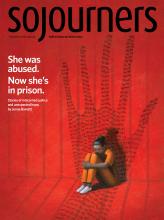WALTRINA MIDDLETON'S VOICE lifts you to the highest highs with bellows of crisp spoken word. Seamlessly, her croons can plunge you down the rhythm of any blues-laced freedom song. Your heart is gripped with deep, rolling riffs of truth spoken.
Harnessing the power of pain is just one of her many spiritual gifts. Middleton is an ordained minister, activist, and artist with roots in the Gullah Geechee community in South Carolina. A self-professed country girl, she grew up in Hollywood, S.C., on the coastal Gullah Sea Island of Yonges, about 30 minutes outside of Charleston.
“It was beautiful—a swampland with dirt roads, farm, and fields,” she told Sojourners. “I made my grandparents’ hogs my pets before I realized they were actually dinner.”
It’s been a winding road on the path to self-discovery for Middleton, but she says music was there from the very beginning. “Music was central to our family,” she said. “It was an intergenerational medium that brought us together, but also rooted us in our faith.”
Her grandparents had 16 children, and all of them could sing or play an instrument. The family put together a group called the Middleton Gospel Singers that toured the local church community. “Part of the country circuit is to have some kind of gospel group,” she said. “The women in my family were the instrumentalists. I was always with my family when we would be in church all day going to these programs. The whole point was to worship God. It was just something that you did.”
Even when there wasn’t a church function or performance, Middleton says music was a part of her everyday life. “We had this big ol’ barn, and we would be in the barn sitting, rehearsing, and practicing,” she said. “Sometimes there would be a fire; sometimes people would just come, listen, and talk. While they were rehearsing, we would sit out there and eat crab.”
At these family gatherings, her artistic flair began to take shape. She admired her older cousins and says they heavily influenced her style. “They had this depth to them that I couldn’t describe,” she said. “It was very low and lamenting. I found myself trying to imitate their style. It also taught me that worship could also be lamenting.”
Read the Full Article

